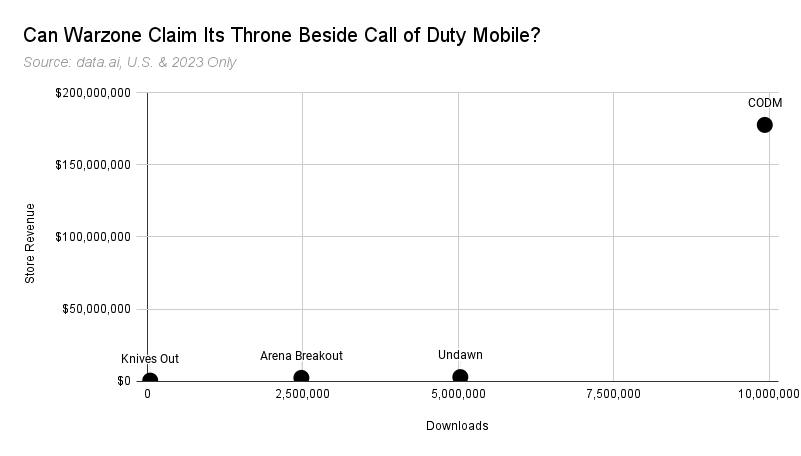
Call of Duty Mobile (CODM) provided a watershed moment for mobile, proving Western gamers are ready for virtual dual analog stick controls and heralding a wave of Eastern titles to the West. Or did it?
Four years after CODM’s launch, the graveyard of aspiring mobile shooters’ is extraordinary: Undawn, Lost Light, Blood Strike, Valorent (canceled), and Battlefield (canceled). These are high-profile games, too: Undawn reportedly had a 300-person team on a $130M budget to only amass $300k in revenue last month. Conversely, a few titles have succeeded, albeit primarily outside of the West: PUBG Mobile ($1.1B), Crossfire (~$500M), Arena Breakout ($50M), and Knives Out (~$109M). However, in the U.S., CODM accounts for 97% of revenue. Surely, this sets up Warzone Mobile for success?
CODM embraced an auto-fire mechanic to navigate the inherent awkwardness of mobile FPS controls. Dual analog sticks require both thumbs, and without shoulder triggers, mobile players need to lift one of their thumbs to fire. Instead, autofire will shoot once a target aligns in the crosshairs. While less competitive (top players use their index finger to fire, creating a c-shape with their hand), the title is more accessible. Much of this accessibility is awash in Warzone’s battle royale (BR) mode. Warzone’s maps are MUCH larger than CODM’s maps, meaning draw distances are much longer. This makes it harder to spot enemies, penalizing autofire players. CODM’s BR mode avoids these problems by switching to third-person.
Spearheaded by famed dev Timi (w/ATVI PMs), CODM flawlessly executes the Chinese liveops strategy: massive content and loot box monetization. This approach, mirrored by Apex Mobile (another Timi collab w/EA PMs!), seemed viable until transatlantic drama prematurely ended its run. Warzone is also a product of transatlantic drama but with a far more seductive pitch of simply translating existing HD Warzone content to mobile. This allows Activision (ATVI) to amortize cost across a wider swath of players and finally achieve Kotick’s Call of Duty “platform” fantasy. On the other hand, this comes as a double-edged sword, as the HD version constrains monetization mechanics and content of the mobile SKU. There’s also the overlooked question of the SKU’s target audience: HD gamers looking for COD on the go? That can’t be a giant Venn diagram, considering CODM is a superior product on nearly every front, including technically.
Roblox and Fortnite Mobile underscore the inevitable rise of virtual analog sticks in mobile gaming. As the largest Western shooter IP, COD paired with Chinese content quantity and monetization, created a category on its own. This should be an area of Western domination. However, Valorent and Battlefield’s inability to ship is a blemish on Western development. Still, riches await if publishers are willing to subdue their HD instincts and respect the mobile paradigm. Next up: Rainbow Six: Seige Mobile.